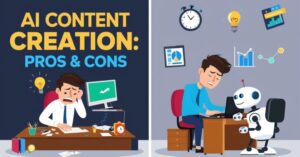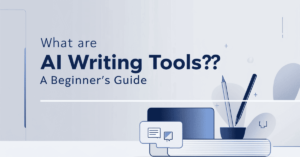Let’s cut to the chase: You’re drowning in deadlines. Emails, blogs, social posts—it’s a never-ending cycle. I’ve been there too, staring at my screen at midnight, wondering if I’ll ever finish that 2,000-word article. Then AI waltzed into my life, promising to be my superhero. But here’s the truth: AI isn’t a hero or a villain. It’s a tool. And like any tool, it can build or break your workflow, depending on how you swing it.
I’ve spent years using AI for content—sometimes cheering, sometimes cursing. Let’s break down the real pros and cons without the hype. No jargon, no sugarcoating. Just raw, relatable insights.
Pro #1: Speed – Because Time Is Money
The Problem: You need 10 blog ideas by noon. Your brain? Blanker than a new Word doc.
The Agitation: Manual brainstorming eats hours. I once wasted a whole morning rewriting a single intro. My client? Not impressed.
The Solution: AI cranks out ideas fast. Tools like ChatGPT or Jasper can generate 10 blog titles in 30 seconds. Last week, I used AI to draft a week’s worth of social posts while sipping my coffee.
But Here’s the Catch: Speed ≠ quality. AI drafts need editing. I learned this the hard way when I published an unedited AI post that called “SEO” a “delicious sandwich topping.”
Con #1: Lack of Originality – The Robot Cookie-Cutter Effect
The Problem: Your content sounds like everyone else’s.
The Agitation: AI tools scrape existing data. I once generated three articles on “digital marketing trends,” and all started with “In today’s fast-paced world…” Yawn.
The Reality: AI can’t replicate your voice. Your audience craves authenticity—not recycled phrases. I now use AI for rough drafts, then inject personal stories. For example, I’ll add how I messed up a client’s campaign before nailing it.
Pro #2: Scalability – From One Post to 100
The Problem: Your client wants 50 product descriptions. By Friday.
The Agitation: Writing manually? That’s 10 hours of your life gone. I once pulled two all-nighters for a similar task. Never again.
The Solution: AI scales content like a boss. Tools like Copy.ai or Writesonic can generate bulk drafts in minutes. I used AI to create 30 meta descriptions for an e-commerce site last month. Took me 20 minutes to tweak and approve.
Watch Out: Scalability works best for formulaic content (product descriptions, FAQs). For thought leadership? You’ll still need human brains.
Con #2: Quality Control – The Grammar Gremlins
The Problem: AI loves to hallucinate.
The Agitation: I trusted an AI tool to write a “fact-checked” section on climate change. It cited a study from “the University of Narnia.” Cue facepalm.
The Fix: Always fact-check. I now cross-reference AI content with trusted sources. Tools like Grammarly help catch odd phrasing, but human eyes are irreplaceable.
Pro #3: Cost-Effectiveness – Budget-Friendly Muscle
The Problem: Hiring writers burns cash.
The Agitation: As a solopreneur, I once spent $500 on a single blog post. It hurt.
The Solution: AI tools cost pennies compared to human writers. Most free tiers (like Rytr or Simplified) handle small projects. I saved $200/month using AI for first drafts, then hiring an editor for polish.
But Remember: Cheap ≠ sustainable. For complex topics (legal, medical), invest in experts.
Con #3: Ethical Risks – The Plagiarism Trap
The Problem: AI “borrows” content a little too well.
The Agitation: I ran an AI draft through Copyscape and found 20% matched a competitor’s site. Yikes.
The Workaround: Use plagiarism checkers religiously. Tools like Quetext or Grammarly’s premium plan help. I also add unique case studies to differentiate my content.
Pro #4: Data-Driven Insights – SEO on Autopilot
The Problem: You’re guessing keywords.
The Agitation: My early blogs ranked nowhere. I’d stuff keywords like “best pizza in NYC” into posts about SaaS. Google wasn’t amused.
The Solution: AI tools like SurferSEO or Frase analyze top-ranking content and suggest keywords. I doubled my organic traffic in 3 months using their data.
Just Don’t: Blindly follow AI. Keep your audience’s needs front and center.
Con #4: Overdependence – Losing Your Creative Muscle
The Problem: You forget how to think.
The Agitation: I leaned on AI so much that my first manual draft in months read like a robot wrote it. My editor asked, “Did you forget how to be human?”
The Fix: Balance is key. I now set “AI-free hours” to brainstorm or write raw. It keeps my creativity sharp.
The Balancing Act: How I Use AI Without Losing My Soul
Here’s my workflow:
- Research: AI finds trends and keywords.
- Draft: AI writes a skeleton.
- Edit: I add stories, humor, and heart.
- Polish: Tools like Hemingway clean up clunky sentences.
Example: This blog’s outline was AI-generated. But the jokes about “University of Narnia”? All me.
Final Take: Should You Use AI for Content?
If you’re a solopreneur drowning in tasks: Try AI. It’ll save time and sanity.
If you’re a perfectionist: Tread carefully. AI needs your human touch.
If you’re scared of tech: Start small. Use free tools to draft emails or social posts.
I won’t lie—AI isn’t magic. But used wisely, it’s the sidekick you never knew you needed. Now go create something awesome. 🚀








